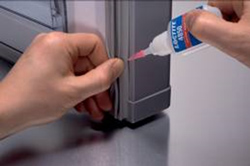
Posted to News on 16th Jul 2015, 17:56
What can be achieved with instant adhesives today?
This article form Henkel, the company behind the Loctite brand, outlines what can be achieved with the current generation of instant adhesives, including the latest gap-filling types.

Modern instant adhesives can often help to make industrial manufacturing processes faster, safer and more economical. They also create new design opportunities for series production. But in order to get the best results, it is essential to select the optimum product. To make sure that all the benefits of this bonding technology can be fully exploited, Henkel's Loctite brand offers a broad range of instant adhesives tailored to meet the specific needs of the manufacturing industries.
Adhesive bonding is one of the most important techniques employed to join materials in modern manufacturing processes. When properly selected and applied, adhesives can achieve lasting bonds between virtually all materials in any combination. Users can choose from a variety of bonding technologies to find the best for their application and requirements. Instant adhesives are playing an increasingly important role in industrial manufacturing, where they offer many advantages over traditional material-joining techniques such as ultrasonic and solvent welding or mechanical fastening methods such as clipping or bolting.
Fast and versatile

In addition to speeding up processes, cyanoacrylates also adhere to a very broad spectrum of different materials. They can be used to bond similar or dissimilar combinations of plastic, rubber, metal, textile, wood or paper materials without problems and without damaging the materials either chemically or thermally. This performance capability makes cyanoacrylates especially suitable for bonding sensitive materials such as plastics, rubber or latex to one another or to metals. Another point in favour of adhesive bonding is that it achieves full-surface joining rather than joining only at isolated, highly stressed contact points as is usual with conventional techniques. Stress peaks can therefore be avoided.
Because they are very versatile and enable fast, easy and economical processing, cyanoacrylates can now be found in many different industrial applications. Examples include bonding rubber feet to ABS housings, attaching clips and switches to mobile electronic devices, and forming flexible gaskets on steel. Moreover, this bonding technology can often replace mechanical constructions - for example, the frames used for the mechanical fixing of heat-sensitive materials such as foam. This results in simpler and more aesthetically pleasing structures that can be built faster while reducing manufacturing costs by saving on materials.
Multipurpose and specialised instant adhesives
Cyanoacrylates are generally characterised by their ability to create high-strength bonds with very good ageing resistance, even in very small gaps. Only small amounts of adhesive are required to create high-performance bondlines with a strength that is often higher than that of the materials being joined.
But to get the best results, choosing the right product is essential. Loctite therefore offers users a broad range of industry-proven cyanoacrylates. While multipurpose products already deliver very good results for bonding a variety of different material combinations, speciality products are available with additional specifically engineered characteristics to considerably extend the spectrum of possible applications. Powerful adhesives are offered even for difficult-to-bond plastics such as PP, PE, POM, PTFE or silicones.
Instant adhesives with gap-filling capability

Users also benefit from significantly improved handling. The transparent cyanoacrylate Loctite 3090 is a high-viscosity gel, which allows easier application to difficult vertical surfaces - without dripping. Another new feature is the convenient two-chamber syringe packaging that enables precise and clean application. Unlike one-component systems, Loctite 3090 does not depend on the moisture on the surfaces to cure, but has an additional activator. The two components are dispensed into an integrated static mixer, which ensures that curing is triggered within the defined time frame, regardless of moisture or temperature, and that the components are always mixed in the right ratio. The adhesive has a working time of 90 to 180 seconds after application. The bond is then strong enough for use or downstream processing of the joined parts. As for Loctite 4090, while a typical epoxy has a minimal fixture time of 10 minutes, Loctite 4090 requires just 5 minutes.
Follow the link for more information about the Loctite Success Secured campaign; the microsite has customer case studies, videos, an adhesive selection 'wizard', webinars and a wealth of other useful information.






























